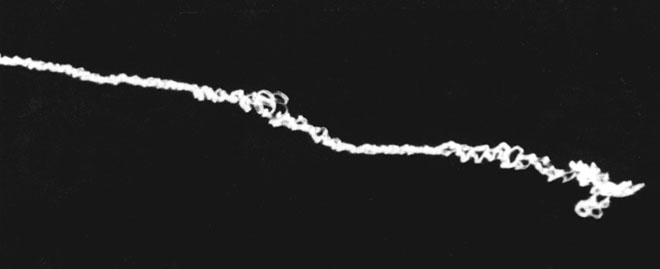
No Paul, That's Not Correct!
How two scientists reacted differently to belief-challenging data.
by Bruce Cornet, Ph.D.
Table of Contents
On 7 July 1992 Bruce Cornet and Ellen Crystall witnessed something that would ultimately end Cornet's career at Lamont Doherty Earth Observatory when his colleague and boss could not accept what the photographs showed, and instead challenged Cornet's integrity and honesty. At that moment a 23 year old friendship abruptly ended, which led to Cornet resigning his position at Lamont. But before I retrace the incriminations and errors in judgement, I need to present the facts. Then you be the judge.
Cornet had been out in the field for only about two weeks collecting data and experiencing first hand what Crystall had claimed in her book, Silent Invasion. This was Cornet's second trip to the Pine Bush hotspot with Crystall, who wanted to show him some of the areas where she had observed AOP. All of this was very new to Cornet. He had no idea of what was in store for him that night, and how it would change his life.
That night Crystall picked up Cornet in Middletown, NY, at his condominium, and she drove to the north of the hotspot. She wanted to show Cornet the area along Bruyn Turnpike where she had sighted AOP in the 1980's. She drove past the spot where Cornet had been shot while taking magnetic readings on 18 June. She turned west onto Bruyn Turnpike from Albany Post Rd. It was a very rural setting, with fields and farm buildings, forests, rivers, and hills. The location is just west of the Wallkill River, and across from Wallkill, NY, which is located on the east bank of the river. Bruyn Turnpike (called Hoagerburgh Rd. on old maps) crosses the valley from east to west for a distance of 1.4 miles before a name change to Wallkill Avenue occurs at Flury Rd. at the ridge on the west side of the valley.
There was no one else on the road, and visibility was excellent. Except at a small hill, they were able to see the road rise up onto the ridge to the west. They crossed the bridge at Dwaar Kill (river) and then saw a pair of headlights coming towards them. The lights were the brightness and size of car headlights, but there was a problem. The pair of lights was not on the road. The lights were just above tree top level at the ridge, and moving towards them at about the rate a car on the road would move. The lights followed the terrain as they descended with the topography to the left of the road (see map below). Cornet expressed concern that this might be a small plane in trouble, and the pilot might be preparing to make an emergency landing on the road in front of them. Crystall agreed and stopped her car at a gravel driveway to a residence on the right side of the road. She backed up quickly and drove onto the driveway, where she parked her car. Cornet quickly got out and set up his tripod and camera at the driveway entrance, while Crystall prepared her camcorder. By the time Cornet had finished preparing his camera for a picture, the lights had reached their location on the other side of the road. But instead of moving past them to the east as a small plane would have done, the lights stopped and hovered. At that point both Cornet and Crystall knew that this was no small plane. It was not a helicopter either, because there was no sound of chopper blades or engine. The lights just bounced around in the air like water droplets on a hot skillet.
Cornet opened the shutter to his camera and began taking his first time exposure. Film type: Black & White. The time was 10:36 pm. This is what he got:

Shortly after he began the time exposure, the AOP began to move east again. Initially the pair of headlights continued to face them from across the road, but then turned towards the direction of previous movement. However, the AOP slowed down again and turned its lights back towards them for a moment, as if to take another look, and made some additional small loops in the air. Then it turned (its lights) again towards the east as it departed.
Cornet kept the shutter to his camera open until the AOP had moved just beyond camera range, then closed the shutter and rotated his camera to the left for the next shot in sequence. During the entire event his camera did not move randomly, because it was securely attached to a stable tripod. The above image represents how the lights moved. Careful examination of the image will reveal motion that could not be duplicated even by a hand-held camera. The loops are just too small and precise. Additional data is presented below to prove that such motion could not have been generated by a hand held camera.
When Cornet opened the shutter for the second time exposure (photo #2), the AOP did something unusual. It dropped at least ten feet in altitude, and then continued to move eastward. The descent in altitude corresponded exactly with the opening of his camera shutter, as indicated below. The downward movement included an altitude correction as the AOP rose slightly in altitude. You can see the tree tops clearly in the photograph, and can see that the AOP was now only about ten feet above the trees. The tree outlines would not have been recorded unless the camera was completely stationary and did not move during the exposure.

Cornet kept the shutter open until the AOP reached what he estimated to be the next limit to camera field-of-view, closed the shutter, and then rotated the camera to the left for the third shot in sequence. But the AOP did the same thing again: Just as he opened the camera shutter, it dropped in altitude about the same distance, and then continued moving eastward. A daytime image of the tree line has been superimposed on top of the actual image, so that you can appreciate the proximity to tree tops as the AOP moved ever closer to contact with tree branches. Once the lights were moving between tree tops, only a couple records of their position were recorded in photo #3 (upwards pointing arrows).

The AOP then disappeared into the forest. Cornet returned the next day to take a daytime photograph, and to get an accurate compass reading for the point of disappearance. The point of last light on the photograph (left-most arrow) occurs just above the Dwaar Kill (river). When Cornet visited that location with his Proton Precession Magnetometer 18 days later, he recorded some unusual electromagnetic effects at that location.
The map below shows Bruyn Turnpike (as Hoagerburgh Rd.), the path of the AOP (red arrow), the place where the AOP disappeared into the woods (red X), and the place Cornet and Crystall were standing (black X at road). The compass direction of the last sighting is 178 degrees. The numbered dots represent stations where magnetic readings were taken. For a magnetic map generated from these data, see The Martin Story or go to a map enlargement.
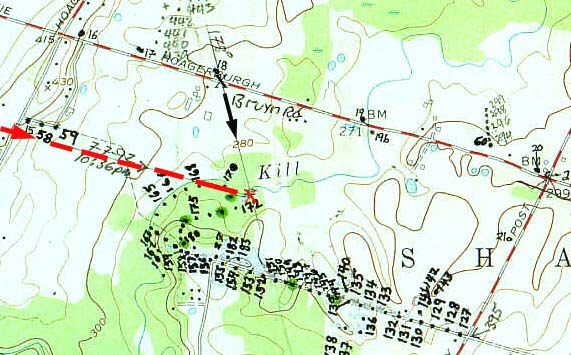
The magnetic readings taken 18 days after the sighting are given in the table below. Old mining pits were found around the western and northern flanks of the hill. Very large trees were growing in all of them, indicating that mining activity stopped more than 70-100 years ago. Anomalous magnetic readings were recorded in one location where a number of pits are clustered. Stations #159 and #160 mark the locations of those pits. Outcrops of rock occur on their steeper sides. The magnetic anomalies are possibly due to remnants of iron ore or iron tools buried in the soil.
But when Cornet took measurements near the Dwaar Kill (river) in the area where the AOP disappeared, the battery charge on his magnetometer began to fluctuate. Every time he took a reading, the remaining charge in the batteries was also given. He began to see the indicated level of charge drop rapidly from one station to the next, and then gradually return back towards normal, only to drop again. When he was closest to the area of AOP disappearance, the battery charge remained the lowest and did not come back up until he left the area. Something in the area caused a slight electrical dampening effect. Had the battery charge dropped much below 9.5 on the gauge, magnetic measurements could no longer be trusted for accuracy.
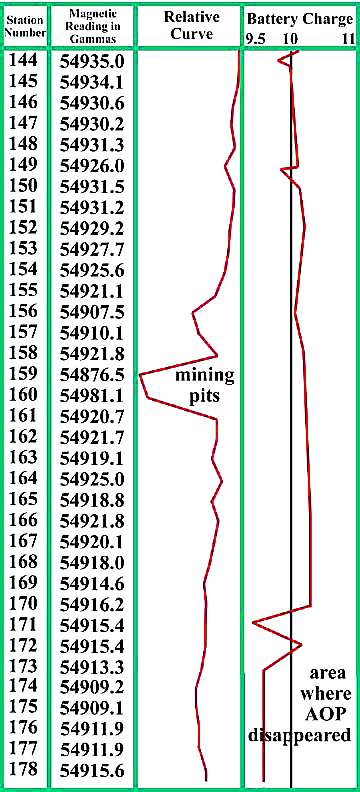
The daytime image from the same location the photographs were taken is shown below, along with the actual path taken by the AOP, based on superposition and matching of nighttime tree top silhouettes with the daytime picture.
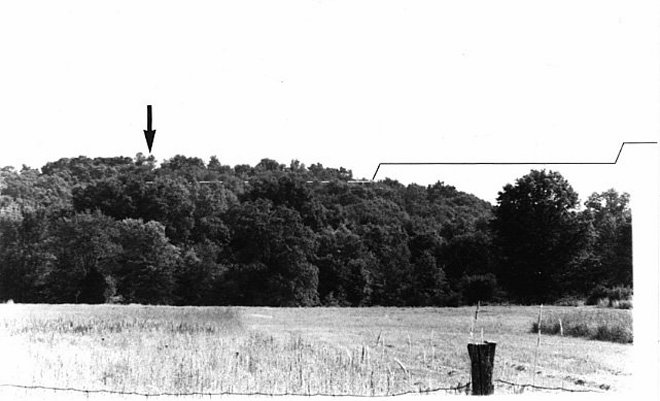
OK skeptics, is this the path of a conventional aircraft? Is this the behavior of a conventional helicopter? No pilot in his right mind would fly a helicopter that close to tree tops at night, lest the blades might hit a branch or tree he did not see. In order to appreciate the reality of what happened, you need to examine a photograph taken of an AOP in August 1992 (below), which shows similar looping of paired lights. The gaps in the lights were caused by the AOP passing behind tree tops, which indicates its extremely low altitude.
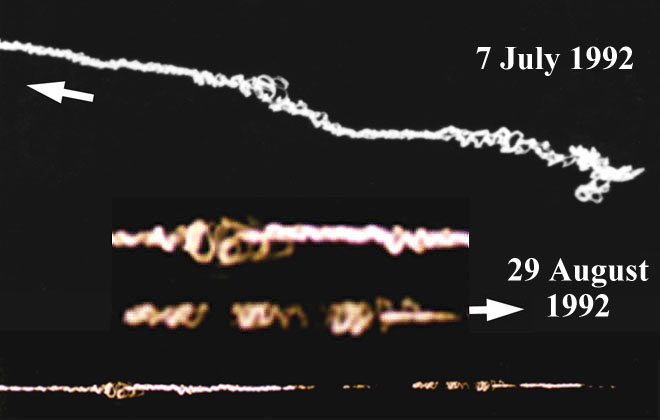
When the negative was photographed under a microscope and enlarged as a print, there can be no competent doubt that the movements captured on film represent actual movement of the lights, and not camera movement. That is because the non-uniform intensity (brightness) of the lights changes with motion, while the width does not change. If intensity were due to time of film exposure, the width of the lights on the film should have changed if there was only one source of photons (the tungsten filament) as is the case for conventional lamps. There is also the problem of color: In the color images above the lights changed color to orange when the loops were made, but returned to full brightness and white after the loops were completed. Camera movement will not produce this affect!

In order to illustrate my point, please examine the images below taken of a conventional jetliner using the chopper device - a three-bladed wheel that chops the light traces on a time exposure according to the rate at which the lights are moving.
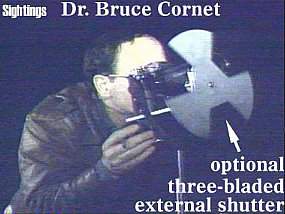
Cornet using the chopper device.
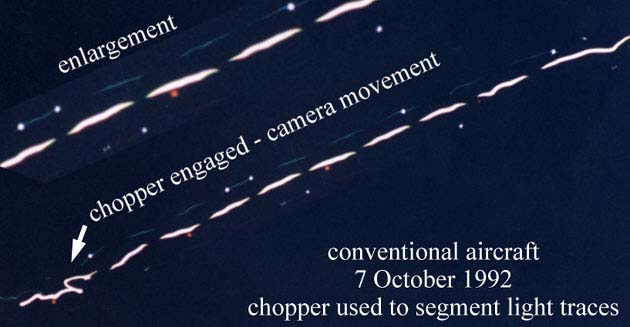
As the blades of the chopper occlude the lens, the amount of light entering the lens decreases proportionate to the amount of occlusion and the intensity of the light. That is the reason the light traces taper to points between the chops - the points being the brightest part of the lights. The camera jiggled when the chopper was engaged, due to the angular momentum of the blades as they picked up speed. In no case does the light continue across the chop, because the intensity of the light was not enough to expose the negative when lens occlusion by a blade was greater than 90%. During the relatively slow movement of a camera jerk the light width decreases only minimally, but does not break up into strands of light as in the examples of AOP lights. The difference is major and significant. The kind of movement captured in the above time exposures of AOP loop patterns cannot be duplicated by camera movement. That is because the amount of movement and the number of loops are at a higher frequency than at which the camera, mount, and tripod can vibrate naturally. But this is not the only reason why they are different.
Below is a photograph (30 July 1993) of conventional jetliner lights. Oscillations were induced by gently rapping the same camera lens with a tuning fork. The shape of the oscillations is controlled by the mechanical properties of the tripod and mount, thereby limiting the wave form to simple sine wave shapes with few loops. Note: All the lights move simultaneously, which is not the case for the 7 July AOP. If all lights move simultaneously and in sync, the facts implicate the camera, but if they move independently, then the source is implicated for the moves.
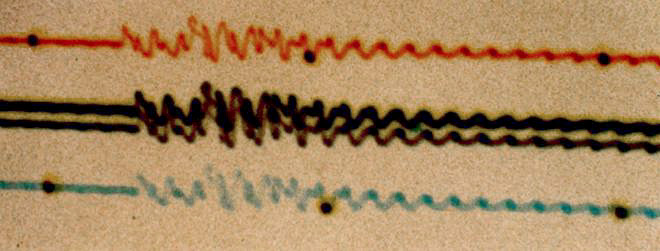
Below is an enlargement of the AOP loops made during the first time exposure. The details clearly document the differences. Note that the AOP was turned to face the camera at the right side of the image (headlights far apart). It then rotated clockwise or turned down direction as it began to move towards the left. This type of change in orientation cannot be duplicated by camera vibration or movement. In other words, the lights move independently of one another. That fact proves that the motion indicated by the light traces originated at the source of the lights, and not at the camera.
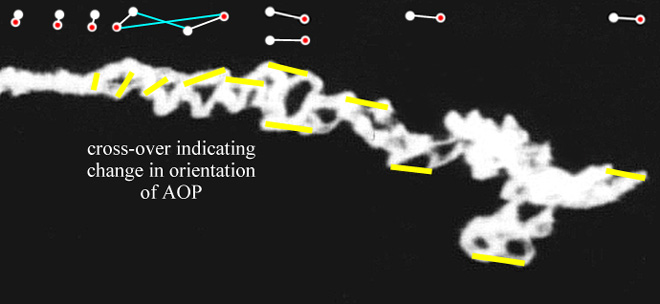
On 3 January 1993 a story was published in the Sunday magazine by the Middletown Record newspaper called, UFOs True Believers. It featured several people doing research and investigation into the Pine Bush phenomenon, including Ellen Crystall and Bruce Cornet. Photo #1 taken on 7 July 1992 was featured at the top of the article. A secretary, who worked at Lamont and lived in Middletown, NY, saw the article and recognized my name. She passed a copy of the article to my boss's partner, who passed it on to Paul. When I saw the magazine on his desk, I asked him if he had read the article, and he said, "Yes" in a displeased tone of voice. Realizing that he was already aware of my extracurricular interests and study, I asked him what he thought of the image at the top of the article.
What I say below is not directed specifically or personally at my former associate (I am using his case as an example so that others will hopefully try to avoid making the same mistakes), but instead at all scientists, philosophers, and engineers who are unwilling to examine the facts before making a personal judgement which negatively affects the lives of other people.
Paul said, "The loops were caused by a hand-held camera. You were holding the camera." He would not accept my statement that the camera was stationary and mounted on a tripod. Apparently, he could not accept the implications of what the pictures show. He seemed upset that someone who worked so closely with him was now publicly connected to the UFO phenomenon. Instead of asking to see more evidence before making any judgement, he chose to deny my statements of fact (because they were anecdotal), to not examine the original photographs in detail, and to end our friendship with a personal attack on my credibility, my integrity, and my honesty. In essence, he chose status and a professional position at Lamont and Columbia University over a 23 year personal friendship and professional relationship. Why should the stakes be so high for interest in any poorly understood phenomenon? His kind of reaction is not logical or scientific!
A major part of the problem why AOP and unconventional flying objects have resisted scientific analysis for so long is not, contrary to belief, because the phenomenon is elusive (it was certainly not elusive for me), but because of such attitudes and behavior amongst professionals, who should know better. Instead, a well-planned instrument study of the phenomenon should be conducted by scientists and engineers, and governments should openly fund such projects. More importantly, there should never be any punishment or price to pay for doing methodological scientific research on any subjects for the purpose of discovery and benefit to humankind.
It is one thing to have a different opinion or belief, but when that opinion or belief bears teeth and results in behavior that injures or slanders another person without justification, it represents the worst that society, culture, and science have to offer. Wars are fought over similar ignoble causes of injustices and personal beliefs.
The 7 July 1992 event is unusual in several respects, because it associates a small object capable of producing a pair of bright lights, capable of flying and hovering, and capable of flying between tree tops at night, with a location on the ground, which during daylight shows no indication that anything aerial landed there or was hiding there. And yet some sort of magnetic anomaly was detected at the last known location of the AOP.
What was that AOP doing there that night? When Crystall and Cornet stopped and they got out of the car to observe the lights, the AOP stopped also as if to observe them. If it had not wanted to be photographed, it could have continued on or turned off its lights. Instead, it made movements and changed altitude twice before disappearing into the woods.
The AOP behaved as a single object would behave, and not as two separate objects or lights (i.e. orbs). The fact that it dropped in altitude at the beginning of the last two time exposures implies more than synchronicity. It implies intent on the part of the pilot or AOP intelligence to provide feedback data, which would allow the photographer (and anyone who studies the photographs) to know that something more than normal human consciousness was at work. Similar synchronicity between time exposures and AOP movement was recorded numerous times by Cornet in the field, so many times in fact that it became a trademark of these types of AOP.
Experiments have shown that some dogs know when their caretaker has started to come home long before their normal senses could pick up any cues. If a dog can pick up on the behavior and/or thoughts of a human, why not other non-human intelligence? Just because telepathic ability amongst humans has not been proven scientifically does not mean that telepathy does not exist. Instead, one might think there is a conscious trend in our Western culture to de-evolve (regress) or lose any natural abilities which cannot be "adequately" qualified and quantified by science. We even have a term for such abilities: Supernatural! But there may be nothing supernatural about such abilities - especially if dogs have it! Let's not limit the data set by making it fit our narrow field of view or by defining reality in such a way that supporting data are excluded (see ETI Communication). Unfortunately, the behavior of Paul is not unique, nor restricted to scientists. It seems to be a pathological part of human behavior, because it does what pathology does: Injure our Species. There is nothing Darwinian or "fittest" in restricting science from investigating phenomena that challenge our belief systems. Beliefs are not facts, nor are they truths. At best beliefs are informed opinions, and at worst they are misleading, delusional, and/or irrelevant.
Physician Rupert Holmes outlines the insititutionalized process for silencing many attempts to bring forth new information and ideas from scientific research.
Unwanted scientific information is paralyzed by excessive demands for repetitive proofs. The resulting unwanted knowledge is then denounced by "experts." Papers reporting new results are directly censored by anonymous reviewers who operate as the secret police of scientific thought. These individuals determine which papers are published -- the direct equivalent in modern times of the nihil obstat of the Catholic church. The armory of suppression also includes the perverse use of legitimate technical tools such as statistics, mock attempts at duplication of results, scientific harassment, scientific rumors, and abuse of financial or institutional power. In the final analysis, most scientists operate under an illusion of objectivity, have blind faith that natural phenomenon can be reduced to simple known causes, and fail to see the fundamental contradiction between seeking knowledge and seeking power. (Holmes 1996: 6).
I have intentionally combined a parable and paranormal event in hopes that those who have this disease called denial will recognize it and seek a cure. Then perhaps scientists can get down to the business of investigation AOP and related phenomena with instruments in an attempt to understand what is happening. Support SETV, the scientific Search for ExtraTerrestrial Visitation.
Reference
Holmes, Rupert. 1996. Review of Memory of Water, by Michael Schiff. Newsletter of the Monterrey Institute for the Study of Alternative Healing Arts, January-March, 6-7. (Reprinted from Davis-Floyd, Robbie & St. John, Gloria. 1998. From doctor to healer, Rutgers University Press, New Brunswick, NJ and London: 48.)
Committee on Science, Engineering, and Public Policy, 1995. On Being a Scientist, Responsible Conduct in Research, Second Edition, National Academy of Science, WDC.
Copyright © 1999 Sirius Onion Works
Last modified: October 23, 2005